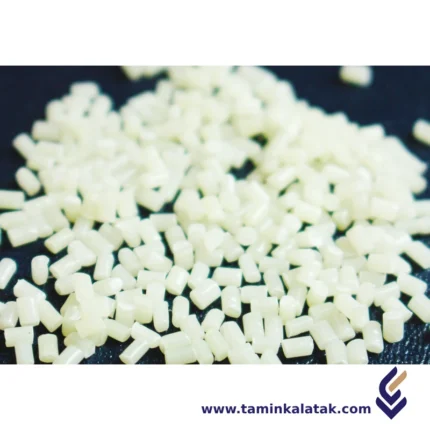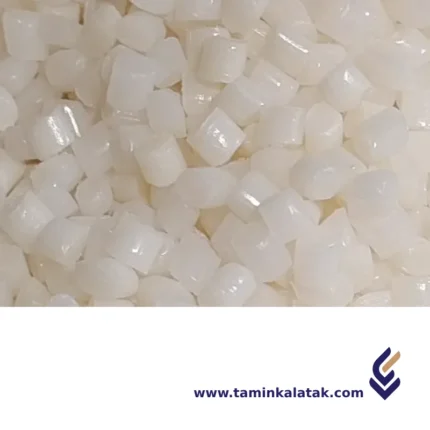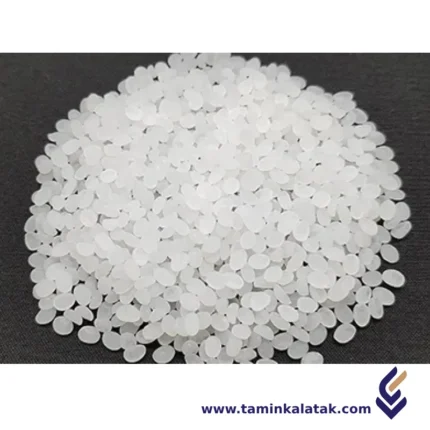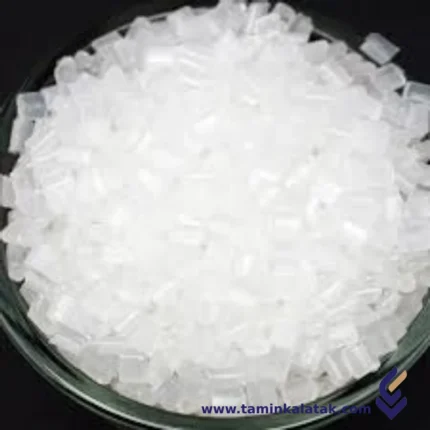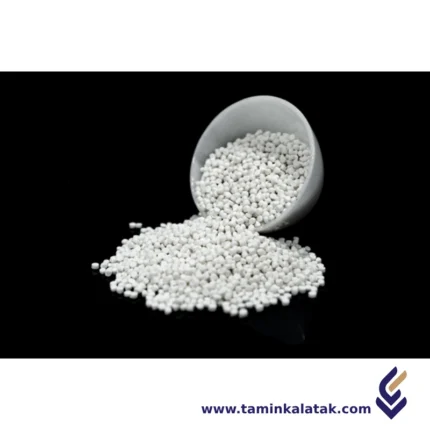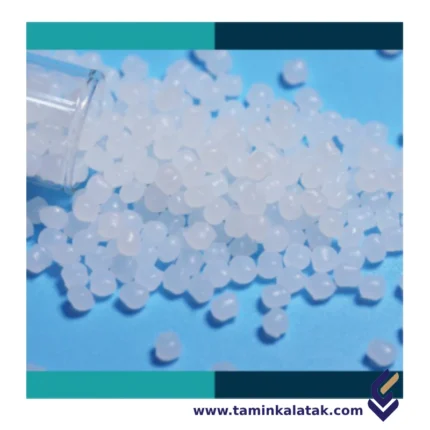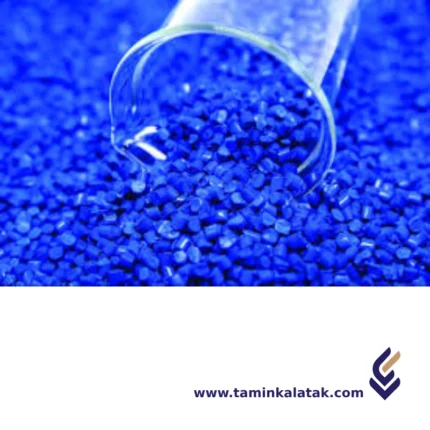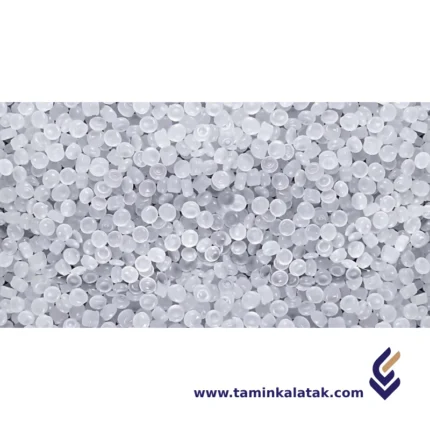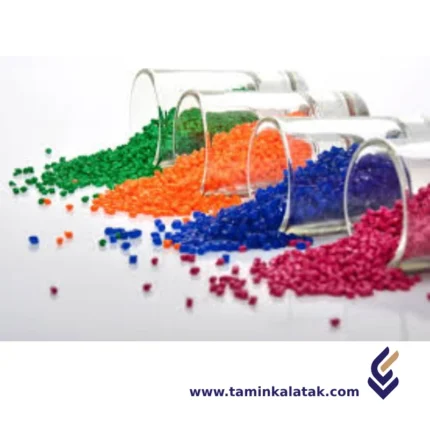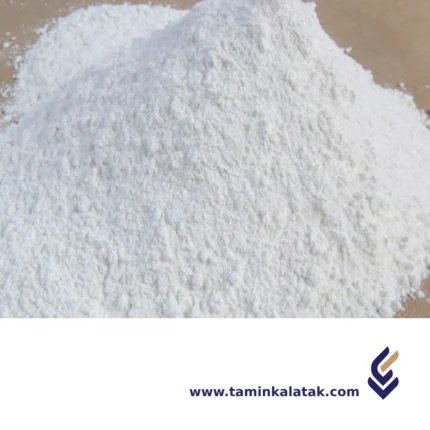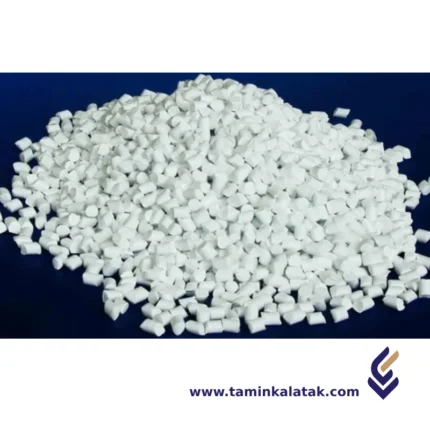Anti-UV Masterbatch
Anti-UV Masterbatch is a specialized additive used in plastic manufacturing to enhance the UV resistance of polymer-based products. It consists of ultraviolet (UV) stabilizers and absorbers dispersed in a carrier resin, making it easier to incorporate into plastic during processing.
StructureThe structure of an anti-UV masterbatch consists of a combination of UV stabilizers, a carrier resin, and sometimes additional additives to enhance performance. The UV stabilizers, which can include UV absorbers and hindered amine light stabilizers (HALS), are the active components that protect plastics from degradation by absorbing or neutralizing harmful ultraviolet radiation. These stabilizers are uniformly dispersed within a carrier resin, which is typically the same or compatible with the final polymer to ensure easy blending during processing. The carrier resin acts as a medium that holds and delivers the UV stabilizers into the plastic matrix. Depending on the application, other additives such as antioxidants, processing aids, or heat stabilizers may be included to improve the overall durability of the final product. The masterbatch is typically produced in pellet or granular form, allowing for uniform distribution when mixed with base polymers during the manufacturing process.
PropertiesAnti-UV masterbatch possesses several key properties that enhance the durability and performance of plastic products exposed to sunlight. It effectively absorbs and dissipates ultraviolet radiation, preventing polymer degradation, discoloration, and brittleness. The masterbatch is designed to be thermally stable, ensuring that it can withstand high processing temperatures without losing its effectiveness. It is highly compatible with various polymers, including polyethylene, polypropylene, PVC, and ABS, allowing for easy incorporation into different plastic formulations. The dispersion quality is crucial, ensuring uniform distribution of UV stabilizers within the polymer matrix to achieve consistent protection. Additionally, anti-UV masterbatch can be tailored to specific applications by combining different types of UV stabilizers, such as UV absorbers and hindered amine light stabilizers (HALS), for comprehensive protection. It also maintains the mechanical properties of plastics over time, reducing surface cracking and extending the lifespan of products used in outdoor or high-exposure environments.
Applications
- Agricultural films, such as greenhouse covers and mulch films, to protect crops from UV damage.
- Outdoor furniture and construction materials, including pipes, sheets, and roofing, to prevent weathering and brittleness.
- Automotive plastic parts, such as dashboards and exterior trims, to resist sun-induced fading and cracking.
- Packaging materials, especially for products sensitive to UV exposure, such as food and pharmaceuticals.
- Electrical and electronic components, ensuring longer durability for plastic casings exposed to sunlight.
- Textile fibers and synthetic fabrics, improving UV resistance in outdoor clothing and industrial fabrics.
Advantages
- Protects plastics from UV-induced degradation, extending product lifespan.
- Reduces discoloration, brittleness, and surface cracking in exposed plastic materials.
- Enhances thermal stability, making it suitable for high-temperature processing.
- Compatible with various polymers, allowing flexibility in application.
- Cost-effective solution compared to using inherently UV-resistant polymers.
Disadvantages
- May slightly alter the color or transparency of clear plastic products.
- Effectiveness depends on the concentration and type of stabilizer used.
- Higher costs compared to non-UV-stabilized plastic formulations.
- Prolonged exposure to extreme UV conditions may still lead to gradual degradation over time.
Antibacterial Masterbatch
Antibacterial Masterbatch is a concentrated additive used in plastic manufacturing to provide antimicrobial properties to the final product. It contains antibacterial agents—such as silver ions, zinc-based compounds, or organic biocides—dispersed in a carrier resin. When incorporated into plastic during processing, it helps prevent the growth of bacteria, fungi, and other microbes, enhancing hygiene and durability.
StructureThe structure of an antibacterial masterbatch consists of a carrier resin, an antibacterial agent, dispersing agents, stabilizers, and processing aids. The carrier resin, such as polyethylene (PE), polypropylene (PP), or polystyrene (PS), serves as the base material that ensures compatibility with the final plastic product. The antibacterial agent is the key active ingredient, which can be silver-based (Ag+ ions), zinc-based (ZnO, Zn ions), organic biocides (such as triclosan or quaternary ammonium compounds), or copper-based (Cu+ ions). These agents work by disrupting bacterial cell membranes, inhibiting their metabolism, or preventing their adhesion to surfaces. To ensure uniform distribution, dispersing agents and stabilizers are added to prevent agglomeration and degradation of the antibacterial particles. Additionally, processing aids enhance the flow properties and thermal stability of the masterbatch during plastic manufacturing. In terms of functionality, the antibacterial particles are encapsulated within the carrier resin and gradually migrate to the surface over time, providing long-lasting antimicrobial protection. This structure makes antibacterial masterbatches highly effective in applications such as medical devices, food packaging, and consumer goods, ensuring improved hygiene and product durability.
PropertiesAntibacterial masterbatch possesses a range of properties that make it an effective solution for antimicrobial plastic applications. It provides broad-spectrum antimicrobial protection, inhibiting the growth of bacteria, fungi, mold, and algae while ensuring long-lasting effectiveness through the gradual release of active agents. Many formulations use a non-leaching mechanism, meaning the antibacterial agents remain embedded in the polymer matrix, preventing washout or depletion. The masterbatch is highly dispersible, ensuring even distribution of antibacterial agents without compromising the mechanical strength or flexibility of the final plastic product. Additionally, it exhibits excellent thermal stability, withstanding high processing temperatures (typically between 200–300°C) without degradation. Many formulations are also UV and oxidation-resistant, ensuring long-term performance in various environments. Chemically, antibacterial masterbatch is compatible with a wide range of polymers, including PP, PE, PET, PVC, and ABS. It meets strict safety and regulatory standards, making it non-toxic and safe for food contact applications, with compliance to FDA, EU, and REACH regulations. Furthermore, it is easy to incorporate into plastic manufacturing processes such as extrusion, injection molding, and blow molding, and can be customized to achieve specific antimicrobial performance levels.
Applications of Antibacterial Masterbatch
- Food Packaging – Prevents bacterial growth on plastic packaging for longer shelf life.
- Medical Devices – Used in surgical instruments, hospital trays, and equipment to maintain hygiene.
- Consumer Products – Incorporated in household items like cutting boards, toothbrush handles, and baby products.
- Textile Industry – Used in antimicrobial fabrics for sportswear, medical textiles, and upholstery.
- Automotive Industry – Applied to interior components to reduce microbial contamination.
- Electronics – Used in device casings, keyboards, and remote controls to prevent bacteria buildup.
- Public Transport & Infrastructure – Implemented in handrails, seats, and handles to maintain hygiene in public places.
Advantages of Antibacterial MasterbatchPrevents Bacterial Growth – Reduces microbial contamination on plastic surfaces. Enhances Product Longevity – Prevents material degradation caused by bacteria. Improves Hygiene & Safety – Ideal for healthcare, food, and consumer products. Odor Reduction – Prevents bad smells caused by bacterial activity. Customizable – Can be tailored to different polymers and processing requirements. Cost-Effective – Long-term savings by reducing the need for frequent cleaning and replacements.
Disadvantages of Antibacterial MasterbatchPotential Toxicity – Some antibacterial agents may raise health concerns. Regulatory Compliance Issues – Must meet strict safety and environmental regulations. Limited Effectiveness – May not work against all bacteria and fungi. Environmental Concerns – Some formulations may contribute to antimicrobial resistance. Increased Cost – Adds to production expenses compared to standard plastics. Performance Variation – Effectiveness can depend on temperature, humidity, and exposure conditions.
Antiblock Masterbatch
Antiblock masterbatch is an additive used in plastic films and sheets to reduce surface adhesion and prevent blocking, where plastic layers stick together after processing. It contains fine inorganic particles such as silica, talc, or calcium carbonate, dispersed in a polymer carrier like PE (polyethylene) or PP (polypropylene).
Structure
The structure of antiblock masterbatch consists of a polymer carrier resin, typically polyethylene (PE) or polypropylene (PP), combined with finely dispersed inorganic antiblocking agents such as silica, talc, or calcium carbonate. These inorganic particles create a micro-rough surface on the plastic film, reducing contact area and minimizing adhesion between layers. The masterbatch is formulated to ensure uniform dispersion of the antiblocking agents, preventing film sticking while maintaining optical properties such as transparency and gloss. In addition to antiblocking agents, the formulation may include processing aids and slip additives to enhance film handling and extrusion performance. The overall composition is designed to provide effective antiblocking performance without compromising the mechanical and optical qualities of the final product.Properties
Antiblock masterbatch has several important properties that enhance the performance of plastic films and sheets. It effectively reduces blocking by introducing micro-roughness on the surface, preventing plastic layers from sticking together. The masterbatch is designed to maintain good optical properties, ensuring minimal impact on transparency and haze, which is especially important for clear films. It also improves the handling and processing of films by reducing friction, often working in combination with slip agents to enhance surface smoothness. The thermal and chemical stability of antiblock masterbatch ensures that it remains effective under high processing temperatures and various environmental conditions. Additionally, it enhances the efficiency of film unwinding, bag opening, and packaging applications without negatively affecting the mechanical strength of the polymer.Applications of Antiblock Masterbatch
- Blown Films – Used in LDPE, LLDPE, and HDPE films to prevent blocking.
- Cast Films – Applied in BOPP and CPP films for packaging and lamination.
- Agricultural Films – Helps prevent sticking in greenhouse and mulch films.
- Shrink and Stretch Wraps – Ensures smooth unwinding and handling.
- Thermoformed Sheets – Reduces adhesion in plastic trays and disposable containers.
- Flexible Packaging – Improves the usability of food and industrial packaging films.
Advantages of Antiblock Masterbatch
- Prevents Film Blocking – Reduces adhesion between plastic layers for easy handling.
- Maintains Transparency – Optimized formulations ensure minimal haze.
- Improves Processing Efficiency – Enhances film unwinding and bag separation.
- Compatible with Various Polymers – Works well with PE, PP, and other film resins.
- Enhances Surface Properties – Reduces friction when combined with slip agents.
- Cost-Effective – Reduces defects and improves production efficiency.
Disadvantages of Antiblock Masterbatch
- Potential Reduction in Clarity – High concentrations may slightly increase haze.
- Can Affect Surface Smoothness – Roughness introduced by antiblock agents may impact certain applications.
- Limited Performance in Thick Films – More effective in thin films than in rigid or thick sheets.
- Possible Interaction with Other Additives – Requires careful formulation to avoid negative effects on slip or anti-static properties.
Antioxidant Masterbatch
Antioxidant masterbatch is an additive used in plastic processing to protect polymers from thermal and oxidative degradation during manufacturing and throughout the product's lifespan. It consists of antioxidants dispersed in a carrier resin, allowing easy incorporation into various plastic materials. Antioxidants prevent polymer degradation caused by exposure to heat, oxygen, and mechanical stress, which can lead to brittleness, discoloration, and loss of mechanical properties.
Structure Antioxidant masterbatch
The structure of antioxidant masterbatch consists of a combination of antioxidants, a carrier resin, and sometimes additional stabilizers to enhance its effectiveness. The antioxidants, which can be primary (phenolic) or secondary (phosphite or thioester-based), work by neutralizing free radicals and decomposing peroxides that cause polymer degradation. These active components are uniformly dispersed within a carrier resin, which is selected based on compatibility with the target polymer to ensure smooth blending during processing. The carrier resin, often polyethylene (PE), polypropylene (PP), or another polymer-specific base, acts as a medium that facilitates even distribution of antioxidants throughout the plastic material. Depending on the application, the masterbatch may also contain synergistic additives like UV stabilizers or processing aids to provide comprehensive protection against thermal and oxidative degradation. Produced in pellet or granular form, antioxidant masterbatch is designed for easy incorporation into plastic formulations, improving the stability and longevity of the final product.Properties Antioxidant masterbatch
Antioxidant masterbatch possesses several key properties that enhance the stability and durability of plastics during processing and throughout their lifespan. It provides excellent thermal stability, preventing polymer degradation caused by high temperatures during extrusion, injection molding, and other manufacturing processes. The masterbatch also offers strong oxidation resistance, protecting plastics from the harmful effects of exposure to oxygen, which can lead to discoloration, brittleness, and loss of mechanical properties. It is highly compatible with various polymers, including polyethylene (PE), polypropylene (PP), polyvinyl chloride (PVC), and acrylonitrile butadiene styrene (ABS), ensuring easy dispersion and uniform protection. Additionally, it enhances processing efficiency by reducing melt viscosity fluctuations, preventing gel formation, and maintaining the integrity of the plastic material. The presence of synergistic blends of primary and secondary antioxidants further improves its effectiveness, offering long-term stability and enhanced resistance to degradation in applications exposed to heat, mechanical stress, or prolonged storage conditions.Applications of Anti-UV Masterbatch
- Agriculture: Used in greenhouse films, mulch films, and irrigation pipes to prevent UV degradation and extend lifespan.
- Packaging: Protects plastic packaging materials from UV-induced weakening, ensuring product safety and durability.
- Automotive: Applied in plastic components like dashboards, bumpers, and exterior trims to prevent fading and cracking.
- Construction: Used in outdoor plastic products such as roofing sheets, pipes, and synthetic wood to withstand prolonged sun exposure.
- Textile and Fibers: Enhances UV resistance in synthetic fabrics, geotextiles, and outdoor banners to prevent fading and degradation.
- Electrical and Electronic Components: Ensures longevity of plastic casings and insulation materials exposed to sunlight.
Advantages of Anti-UV Masterbatch
- Protects plastics from UV-induced degradation, extending product lifespan.
- Prevents discoloration, brittleness, and surface cracking in outdoor and exposed plastic products.
- Enhances thermal stability, making plastics more resistant to high temperatures.
- Compatible with a wide range of polymers, allowing for versatile applications.
- Cost-effective solution compared to using inherently UV-resistant polymers.
- Easy to incorporate into plastic formulations, ensuring uniform distribution.
Disadvantages of Anti-UV Masterbatch
- May slightly alter the color or transparency of clear plastic products.
- Effectiveness depends on the concentration and type of UV stabilizer used.
- Can increase production costs compared to non-UV-stabilized plastics.
- Prolonged exposure to extreme UV conditions may still lead to gradual degradation over time.
- Some UV stabilizers may have limited efficiency under very high-temperature conditions.
Antistatic Masterbatch
Antistatic Masterbatch is a type of additive used in plastics to reduce or eliminate static electricity buildup. It is typically a concentrated blend of antistatic agents dispersed in a carrier resin, which can be easily incorporated into plastic materials during processing.
Structure
The structure of antistatic masterbatch consists of a polymer carrier resin combined with active antistatic agents. The carrier resin is chosen based on compatibility with the target plastic, such as polyethylene, polypropylene, or polystyrene, ensuring uniform dispersion during processing. The antistatic agents can be ionic or non-ionic compounds, often including ethoxylated amines, quaternary ammonium salts, or glycerol esters, which help in reducing surface resistivity. These agents migrate to the surface of the plastic over time, attracting moisture from the environment to dissipate static charges. Some formulations also include synergistic additives to enhance long-term performance or to provide immediate static dissipation. The concentration and type of antistatic agent determine the efficiency, duration, and application suitability of the masterbatch, making it a versatile solution for various industries such as packaging, electronics, and automotive components.Properties
Antistatic masterbatch possesses several key properties that make it effective in reducing static electricity in plastic materials. It has a controlled rate of migration, allowing the antistatic agents to move to the surface over time and attract moisture to dissipate static charges. The masterbatch is designed to be compatible with a wide range of polymers, ensuring uniform dispersion without affecting the mechanical properties of the final product. It provides both short-term and long-term antistatic effects, depending on the formulation, and can work in varying humidity conditions. Additionally, it does not significantly alter the transparency, color, or processability of the plastic. It is thermally stable, meaning it can withstand high processing temperatures without degradation. Some formulations are also food-grade compliant, making them suitable for applications in food packaging and medical devices. The electrical resistivity of the final product is reduced, preventing dust attraction, improving safety, and minimizing electrostatic discharge-related issues in sensitive environments like electronics and industrial manufacturing.Applications
- Used in plastic packaging such as films, bags, and containers to prevent dust accumulation.
- Applied in the automotive industry for interior plastic components to reduce static buildup.
- Used in electronics and electrical components to prevent electrostatic discharge (ESD) damage.
- Integrated into textile and fiber production to reduce static in synthetic materials.
- Utilized in industrial equipment like conveyor belts, storage bins, and plastic housings to prevent static-related handling issues.
- Found in medical and pharmaceutical packaging to maintain cleanliness and safety.
Advantages
- Effectively reduces static electricity, preventing dust attraction and improving product cleanliness.
- Enhances processing efficiency by reducing static-related handling issues during manufacturing.
- Improves safety by minimizing electrostatic discharge, which can be hazardous in electronics and industrial environments.
- Provides both short-term and long-term antistatic effects based on formulation.
- Compatible with various polymers, ensuring easy incorporation without significantly altering material properties.
- Can be formulated to be food-grade compliant, making it suitable for packaging and medical applications.
Disadvantages
- The effectiveness depends on humidity, as many antistatic agents require moisture to function.
- Some formulations have a limited lifespan, requiring reapplication or higher concentrations for long-term effects.
- May slightly affect optical properties, such as reducing transparency in clear plastics.
- In certain cases, migration of the antistatic agent to the surface can cause inconsistencies in performance over time.
- Can increase production costs, especially for high-performance or specialized formulations.
Carbonate Masterbatch
Carbonate Masterbatch is a type of filler masterbatch that consists of calcium carbonate (CaCO₃) dispersed in a polymer carrier resin, such as polyethylene (PE) or polypropylene (PP). It is widely used in the plastic industry to improve the mechanical properties of plastic products, reduce production costs, and enhance processability.
Structure
The structure of carbonate masterbatch consists of finely ground calcium carbonate (CaCO₃) particles dispersed in a polymer carrier resin, such as polyethylene (PE), polypropylene (PP), or other thermoplastics. The calcium carbonate acts as a functional filler, providing improved mechanical properties, cost reduction, and enhanced processability. To ensure uniform dispersion and compatibility with the base polymer, the CaCO₃ particles are often coated with surface modifiers or coupling agents, such as stearic acid, which enhances their bonding with the polymer matrix. The polymer carrier resin serves as a medium to evenly distribute the calcium carbonate during processing, preventing agglomeration and ensuring consistent performance in the final product. The proportion of CaCO₃ in the masterbatch can vary depending on the intended application, typically ranging from 20% to 80%. This structure allows for improved stiffness, thermal stability, and opacity while maintaining the flexibility and processability of the plastic.Properties
Carbonate masterbatch possesses several key properties that make it a valuable additive in plastic production. It has high dispersion, ensuring uniform distribution of calcium carbonate within the polymer matrix, which enhances the mechanical properties of the final product. The masterbatch improves stiffness, rigidity, and impact strength while maintaining sufficient flexibility for various applications. It also enhances thermal stability, allowing plastic materials to withstand higher processing temperatures without degradation. Due to the presence of calcium carbonate, it increases opacity and whiteness, which is particularly beneficial for films, sheets, and molded products. The masterbatch helps in cost reduction by replacing a portion of expensive polymer resin with a more affordable filler without compromising product quality. Additionally, it improves processability by enhancing extrusion and molding performance, reducing shrinkage, and providing better dimensional stability. Its density varies depending on the calcium carbonate concentration, typically ranging from 1.5 to 2.2 g/cm³, and it has a melt flow index (MFI) tailored to match the base polymer for seamless integration into manufacturing processes.Applications
- Used in plastic films such as shopping bags, garbage bags, and agricultural films to enhance opacity and reduce costs.
- Applied in injection molding for household products, containers, and automotive components to improve strength and stiffness.
- Utilized in blow molding for producing bottles and hollow plastic items with better rigidity.
- Incorporated in extruded sheets, pipes, and profiles to enhance mechanical properties and processing efficiency.
- Used in non-woven fabrics to improve stiffness and provide a better hand feel for hygiene products.
- Applied in thermoforming to manufacture rigid packaging trays and disposable containers.
Advantages
- Reduces production costs by replacing expensive polymer resins with calcium carbonate.
- Improves mechanical properties, such as stiffness, impact resistance, and dimensional stability.
- Enhances processability by improving extrusion, injection, and blow molding performance.
- Increases opacity and whiteness, reducing the need for additional whitening agents.
- Provides thermal stability, allowing for high-temperature processing without degradation.
- Reduces shrinkage and warping, leading to better-finished products.
- Eco-friendly as it reduces polymer consumption and can improve recyclability in some applications.
Disadvantages
- Higher filler content may reduce flexibility, making some plastic products more brittle.
- May affect transparency, making it unsuitable for clear plastic applications.
- Can alter surface properties, potentially impacting printability or adhesion in certain cases.
- May require surface treatment for better compatibility with some polymer matrices.
- Increased density can add weight to the final product, which may be undesirable in lightweight applications.
Clarifying Masterbatch
Clarifying masterbatch is a type of additive used in plastic manufacturing to improve transparency, gloss, and mechanical properties in semi-crystalline polymers like polypropylene (PP). It enhances the clarity and brightness of finished products by modifying the polymer's crystallization behavior.
Structure
The structure of clarifying masterbatch consists of a polymer carrier resin, typically polypropylene (PP), combined with a clarifying agent such as sorbitol-based compounds, phosphate esters, or nucleating agents. The clarifying agent works by modifying the crystallization behavior of semi-crystalline polymers, reducing the size of spherulites formed during cooling, which enhances transparency and gloss. The masterbatch is formulated with a precise concentration of additives to ensure uniform dispersion within the polymer matrix. In addition to the clarifying agent, the formulation may include processing aids, stabilizers, and dispersants to improve compatibility, flowability, and thermal stability. The overall structure ensures that when mixed with raw polymer during processing, the masterbatch effectively enhances optical properties while maintaining mechanical strength and process efficiency.Properties
Clarifying masterbatch possesses several key properties that enhance the optical and mechanical performance of polypropylene and other semi-crystalline polymers. It improves transparency by reducing haze and increasing light transmission, giving the final product a glass-like appearance. The masterbatch also enhances surface gloss, making the material more visually appealing. In addition to optical benefits, it increases stiffness and impact resistance, ensuring that the material remains durable while maintaining flexibility. It also optimizes processing by lowering the melting temperature, reducing cycle times, and improving mold release, which enhances production efficiency. Furthermore, clarifying masterbatch is thermally stable, ensuring long-term performance without degradation, and is often formulated to comply with FDA and food-grade safety standards, making it suitable for food packaging and medical applications. Applications of Clarifying Masterbatch:- Food Packaging – Used in transparent containers, trays, and beverage cups.
- Household Products – Applied in storage boxes, kitchenware, and organizers.
- Medical Devices – Used in syringes, vials, IV components, and lab equipment.
- Automotive Components – Enhances clarity in light housings and interior parts.
- Thin-Wall Injection Molding – Improves transparency in cosmetic packaging and electronic casings.
- Blow Molding and Extrusion – Used in clear bottles, films, and thermoformed sheets.
- Enhances Transparency – Reduces haze and increases clarity in polypropylene.
- Improves Gloss and Aesthetic Appeal – Provides a smooth, shiny surface.
- Increases Stiffness and Strength – Enhances mechanical properties without brittleness.
- Optimizes Processing Efficiency – Lowers processing temperature and cycle time.
- Compatible with Food and Medical Applications – Often FDA-approved for safety.
- Reduces Material Costs – Allows for thinner wall sections while maintaining strength.
- Limited Compatibility – Mainly effective for polypropylene, with minimal impact on other polymers.
- Processing Sensitivity – Requires precise temperature control to achieve maximum clarity.
- Potential Cost Increase – Higher-quality clarifying agents may raise material costs.
- Aging and Performance Stability – Some clarifying agents may degrade over time, reducing effectiveness.
Masterbatch Anti algae and moss
An anti-algae and moss masterbatch is a specialized additive used in plastic products to prevent the growth of algae, moss, fungi, and other microorganisms. It is commonly used in applications where plastics are exposed to moisture, humidity, and outdoor conditions.
StructureThe structure of an anti-algae and moss masterbatch consists of a polymer carrier, biocidal agents, UV stabilizers, and dispersing aids. The polymer carrier, typically made of polyethylene (PE), polypropylene (PP), or polyvinyl chloride (PVC), ensures compatibility with the final plastic product and allows for easy incorporation during manufacturing. Biocidal agents are the active components that prevent the growth of algae, moss, and fungi by disrupting their cellular processes or inhibiting their ability to thrive on the plastic surface. UV stabilizers are often included to protect the plastic from ultraviolet radiation, which can accelerate degradation and create conditions favorable for microbial growth. Dispersing aids help evenly distribute the active ingredients throughout the plastic matrix, ensuring consistent protection over time. This carefully formulated combination helps extend the lifespan of plastic products exposed to moisture and outdoor environments while maintaining their aesthetic and functional properties.
PropertiesAnti-algae and moss masterbatch exhibits several key properties that enhance the durability and performance of plastic products in outdoor and high-moisture environments. It possesses strong antimicrobial and biocidal activity, effectively preventing the growth of algae, moss, fungi, and other microorganisms on plastic surfaces. The masterbatch is highly weather-resistant, with the ability to withstand prolonged exposure to sunlight, humidity, and rain without losing its effectiveness. It is often formulated with UV stabilizers to prevent degradation caused by ultraviolet radiation, ensuring long-term protection and maintaining the integrity of the plastic. The dispersion of active agents within the polymer matrix is uniform, allowing consistent performance across the entire product. It is also chemically stable, meaning it does not easily leach out or degrade under normal usage conditions. Additionally, it is compatible with various thermoplastic materials, such as polyethylene, polypropylene, and PVC, making it suitable for a wide range of applications, including roofing materials, outdoor furniture, agricultural films, and drainage systems.
Applications
-
- Agriculture: Used in greenhouse films, mulch films, and irrigation pipes to prevent algae growth.
- Construction: Applied in roofing sheets, tiles, drainage pipes, and water tanks to inhibit moss formation.
- Marine Industry: Helps reduce biofouling on boats, docks, and marine equipment.
- Textile Industry: Used in synthetic outdoor fabrics and geotextiles to prevent microbial degradation.
- Packaging Industry: Applied in food packaging, beverage containers, and water storage units to minimize contamination.
Advantages
-
- Prevents algae and moss growth, extending product lifespan.
- Reduces maintenance and cleaning costs.
- Enhances aesthetic appeal by preventing discoloration and surface damage.
- Improves material durability by protecting against microbial degradation.
- Available in eco-friendly formulations.
- Compatible with various plastic polymers like PE, PP, and PVC.
Disadvantages
-
- Increases production costs due to specialized additives.
- Some formulations may have environmental impacts, especially in aquatic ecosystems.
- Effectiveness may decrease over time as active ingredients degrade.
- Subject to regulatory restrictions depending on the biocides used.
- May affect the recyclability of plastic materials.
Masterbatch Anti fungus and mold
A masterbatch for anti-fungus and anti-mold applications is a concentrated additive used in plastic manufacturing to prevent fungal and mold growth. It is commonly used in polymer processing for products exposed to humid or damp environments, such as packaging, construction materials, agricultural films, and household items.
StructureA Masterbatch anti-fungus and mold formulation typically consists of a polymer carrier, such as polyethylene or polypropylene, which acts as a base resin to evenly distribute the additives throughout the material. The key components are the active anti-fungal and anti-mold agents, which include biocides, fungicides, and anti-microbial agents that inhibit the growth of fungi, mold, and bacteria. These can include chemicals like zinc pyrithione, silver-based compounds, or organosulfur agents. To enhance the processing and performance, fillers such as calcium carbonate or silica may be added, along with stabilizers like UV stabilizers, antioxidants, or light stabilizers to maintain the longevity of the masterbatch. Additionally, processing aids such as lubricants and dispersing agents are often incorporated to improve the flow and dispersion of the ingredients during manufacturing. In some cases, surfactants or pigments might be included to optimize the dispersion and give the product color, though this is less common for anti-fungal and mold masterbatches. These masterbatches are then mixed into the final product, such as plastics or coatings, to provide effective protection against mold and fungal growth.
PropertiesMasterbatch anti-fungus and mold possesses several key properties that make it effective in preventing microbial growth in plastic and polymer-based materials. It provides strong antifungal and antimicrobial protection by inhibiting the growth of mold, mildew, and bacteria, ensuring long-term durability and hygiene of the final product. The formulation is designed for excellent dispersion within the base polymer, allowing uniform distribution of active agents. It is highly stable under various environmental conditions, including high temperatures and UV exposure, preventing degradation over time. Many formulations are non-toxic and comply with regulatory safety standards, making them suitable for applications in packaging, medical devices, and consumer goods. Additionally, these masterbatches maintain the mechanical properties of the base polymer, ensuring that strength, flexibility, and appearance remain unaffected. They are also compatible with a wide range of polymers such as polyethylene, polypropylene, and polystyrene, offering versatility in application. Some variations include moisture-resistant and weatherproof properties, making them ideal for both indoor and outdoor use.
Applications
- Used in plastic packaging to prevent mold growth on food and consumer goods
- Incorporated into medical devices and equipment to ensure hygiene and reduce microbial contamination
- Applied in household products such as plastic containers, furniture, and flooring to prevent fungal damage
- Used in automotive interiors to prevent mold buildup in humid conditions
- Integrated into construction materials like PVC pipes, wall panels, and insulation for long-term mold resistance
- Employed in textiles and synthetic fibers to enhance durability and cleanliness
- Added to coatings and paints to protect surfaces from fungal and bacterial growth
- Utilized in agricultural films and greenhouse materials to minimize mold-related crop damage
Advantages
- Provides long-lasting antifungal and antimicrobial protection
- Helps in extending the lifespan of plastic materials by preventing microbial degradation
- Reduces health risks associated with mold exposure, particularly in medical and food-related applications
- Compatible with a wide range of polymers and processing methods
- Maintains the mechanical and aesthetic properties of the base material
- Some formulations are non-toxic and environmentally friendly
- Enhances hygiene and safety in various industries, including food, healthcare, and construction
Disadvantages
- May increase production costs due to the addition of specialized additives
- Some formulations may have regulatory restrictions for food contact or medical use
- Prolonged exposure to high temperatures and UV radiation can cause reduced effectiveness over time
- The presence of antimicrobial agents may lead to resistance development in microorganisms
- Requires precise formulation and dosage to avoid affecting the physical properties of the final product
Polishing Masterbatch
Polishing masterbatch is a type of additive used in the plastic industry to enhance the surface quality, gloss, and smoothness of plastic products. It is commonly used in injection molding, extrusion, and film production processes to improve the appearance and feel of the final product.
Structure
Polishing masterbatch is a specialized additive used in plastic processing to enhance the surface finish, gloss, and smoothness of the final product. It typically consists of a carrier resin, which is compatible with the base polymer, along with finely dispersed polishing agents, lubricants, and processing aids. The polishing agents, often inorganic materials like silica or wax-based compounds, help to reduce surface roughness and improve optical properties. Lubricants such as stearates facilitate smoother processing by reducing friction during extrusion or molding. Processing aids optimize the dispersion of the active components and ensure uniformity in the final application. The structure of polishing masterbatch allows it to be easily mixed with the base polymer, enhancing the end product’s appearance, reducing surface defects, and improving overall quality in applications like films, sheets, and molded components.Properties
Polishing masterbatch possesses several key properties that enhance the quality of plastic products. It improves surface gloss and smoothness, giving the final product a shiny and polished appearance. The masterbatch enhances scratch resistance, reducing the likelihood of surface defects and wear over time. It also provides excellent dispersion within the polymer matrix, ensuring uniform distribution and consistent performance. With good thermal stability, it can withstand high processing temperatures without degrading or causing discoloration. Additionally, it offers low friction and anti-stick properties, which facilitate easier processing and demolding. Some formulations may also include anti-static or UV-resistant properties to further enhance durability. Overall, polishing masterbatch is designed to improve the aesthetic and functional properties of plastics while maintaining compatibility with various polymer systems.Applications
- Used in plastic films to enhance gloss and smoothness for better visual appeal.
- Applied in injection molding and extrusion processes to improve the surface finish of plastic products.
- Utilized in automotive interior and exterior parts for a polished and scratch-resistant surface.
- Employed in household and consumer goods to enhance the aesthetic quality and durability.
- Used in packaging materials to improve transparency and surface quality.
- Applied in synthetic fibers and textiles to enhance smoothness and reduce friction.
Advantages
- Enhances surface gloss and smoothness, improving the overall appearance.
- Improves scratch and wear resistance, increasing the lifespan of plastic products.
- Provides uniform dispersion within the polymer matrix for consistent quality.
- Reduces surface friction, aiding in smoother processing and demolding.
- Compatible with a wide range of polymers, making it versatile in applications.
- Helps reduce production defects such as flow marks and rough surfaces.
- Can offer additional functionalities like UV resistance or anti-static properties.
Disadvantages
- May slightly alter the mechanical properties of the base polymer, such as flexibility or toughness.
- Can increase production costs due to the addition of specialized additives.
- In some cases, excessive use may affect transparency or optical clarity.
- Not all formulations are compatible with every type of plastic, requiring specific selection.
- Potential for migration over time, which may affect long-term performance in certain applications.
Processing Aid Masterbatch
Processing Aid Masterbatch (PPA) is an additive used in plastic processing to improve the flowability, surface finish, and processing efficiency of polymers. It helps reduce melt fracture, die buildup, and energy consumption during extrusion, injection molding, and blow molding.
Structure
The structure of Processing Aid Masterbatch consists of three main components: a carrier resin, a processing aid additive, and optional dispersing agents. The carrier resin, typically LDPE, LLDPE, PP, or EVA, acts as a medium to evenly distribute the active processing aid within the polymer. The core functional ingredient, the processing aid additive, is usually a fluoropolymer (PTFE-based), silicone-based material, wax, or metal stearate, which enhances polymer flow, reduces melt fracture, minimizes die buildup, and improves surface finish. To ensure uniform dispersion and stability, additional dispersing agents such as compatibilizers, antioxidants, and lubricants may be included. This structured composition allows the processing aid masterbatch to integrate seamlessly into plastic formulations, optimizing melt flow, reducing processing defects, and enhancing the overall quality of extruded and molded plastic products.Properties
Processing aid masterbatch possesses several key properties that enhance the efficiency and quality of plastic processing. It improves the melt flow of polymers, reducing viscosity and enabling smoother extrusion or molding. One of its most significant characteristics is the reduction of melt fracture, commonly known as the sharkskin effect, which results in a smoother surface finish and improved clarity in films. It also minimizes die buildup, reducing maintenance requirements and increasing production efficiency. Additionally, processing aid masterbatch enhances the dispersion of fillers and pigments, ensuring uniformity in the final product. It helps in reducing energy consumption by lowering processing temperatures and extrusion pressure. Furthermore, it provides improved lubrication, leading to reduced shear stress and wear on processing equipment. These properties make processing aid masterbatch essential in applications such as film extrusion, blow molding, injection molding, and wire and cable coatings, ensuring better quality and higher productivity in plastic manufacturing.Applications of Processing Aid Masterbatch
- Blown Film Extrusion: Improves melt flow, reduces melt fracture, and enhances surface finish.
- Cast Film Extrusion: Enhances gloss, clarity, and mechanical properties.
- Pipe and Profile Extrusion: Reduces die build-up and improves surface quality.
- Injection Molding: Facilitates mold filling, reduces cycle time, and improves part appearance.
- Blow Molding: Ensures uniform thickness and better mold release.
- Wire and Cable Coating: Reduces die drool and improves surface finish.
- Sheet Extrusion: Ensures uniform thickness and enhances mechanical properties.
- Recycling of Plastics: Improves melt flow and reduces defects in recycled materials.
Advantages of Processing Aid Masterbatch
- Improved Processability: Enhances melt flow and reduces processing defects.
- Enhanced Surface Quality: Provides a smooth, glossy, and defect-free surface.
- Reduced Melt Fracture: Prevents sharkskin defects and uneven surfaces.
- Energy Efficiency: Lowers processing temperature and energy consumption.
- Increased Output: Boosts productivity by reducing processing time.
- Cost Reduction: Minimizes waste and extends equipment life.
- Better Dispersion: Ensures uniform distribution of additives in polymers.
- Wide Polymer Compatibility: Suitable for polyolefins, PVC, and other thermoplastics.
Disadvantages of Processing Aid Masterbatch
- Additional Cost: Adds to production expenses.
- Compatibility Issues: May require formulation adjustments for some polymers.
- Impact on Mechanical Properties: Overuse may affect strength and durability.
- Temperature Sensitivity: Some additives degrade at high temperatures.
- Environmental Concerns: Some materials may not be biodegradable.
Smoothing Masterbatch
Smoothing masterbatch is an additive used in plastic manufacturing to enhance the surface quality of plastic products. It helps reduce roughness, improve gloss, and eliminate surface defects such as flow marks, weld lines, and die lines.
Structure
Smoothing masterbatch is typically composed of a carrier resin, functional additives, and processing aids. The carrier resin, often polyethylene (PE) or polypropylene (PP), ensures compatibility with the base polymer and facilitates uniform dispersion. Functional additives such as silicone-based compounds, waxes, or specialty lubricants are incorporated to reduce surface roughness and enhance flow properties. Processing aids help in minimizing defects like melt fracture, sharkskin, and flow marks by improving the polymer’s rheological behavior during extrusion or molding. The structure of the masterbatch is designed to be thermally stable and miscible with the target polymer, ensuring effective performance without negatively impacting mechanical properties. It is usually available in granular or pellet form, making it easy to handle and dose during manufacturing processes.
Properties
Smoothing masterbatch possesses several key properties that enhance the surface quality and processability of plastic products. It has excellent dispersion characteristics, allowing uniform distribution within the polymer matrix to ensure consistent performance. The masterbatch reduces surface roughness and enhances gloss by modifying the flow behavior of the molten polymer, preventing defects like melt fracture and flow marks. It also exhibits good thermal stability, maintaining its effectiveness even at high processing temperatures without degradation. Additionally, it improves lubricity, reducing friction between polymer chains and enhancing melt flow, which leads to better mold filling and extrusion performance. Smoothing masterbatch is compatible with a wide range of thermoplastics, including polyethylene, polypropylene, and polystyrene, and does not negatively impact the mechanical properties of the final product. Its ability to enhance surface aesthetics while maintaining structural integrity makes it a valuable additive in various plastic applications.
Applications:
- Blown Film & Cast Film: Enhances transparency, reduces surface roughness, and improves gloss.
- Injection Molding: Minimizes surface defects such as weld lines, flow marks, and melt fracture.
- Extrusion Coating & Lamination: Improves adhesion and surface finish for better product quality.
- Pipes & Profiles: Provides a smooth, uniform surface, reducing friction and wear.
- Automotive & Consumer Goods: Enhances the aesthetic appeal and tactile properties of plastic components.
- Improves surface smoothness and gloss for a high-quality finish.
- Reduces defects like sharkskin, melt fracture, and rough textures.
- Enhances flow properties, allowing better mold filling and extrusion.
- Compatible with various polymers without compromising mechanical properties.
- Improves processing efficiency by reducing friction and internal stress.
- Helps achieve better aesthetics in packaging, automotive, and household products.
- May increase production costs due to the additional material expense.
- Excessive use can affect the mechanical strength of the final product.
- Compatibility issues may arise with certain specialty polymers.
- Overuse might lead to adhesion problems in coating and printing applications.
- Requires precise dosing to achieve optimal performance without compromising quality.

